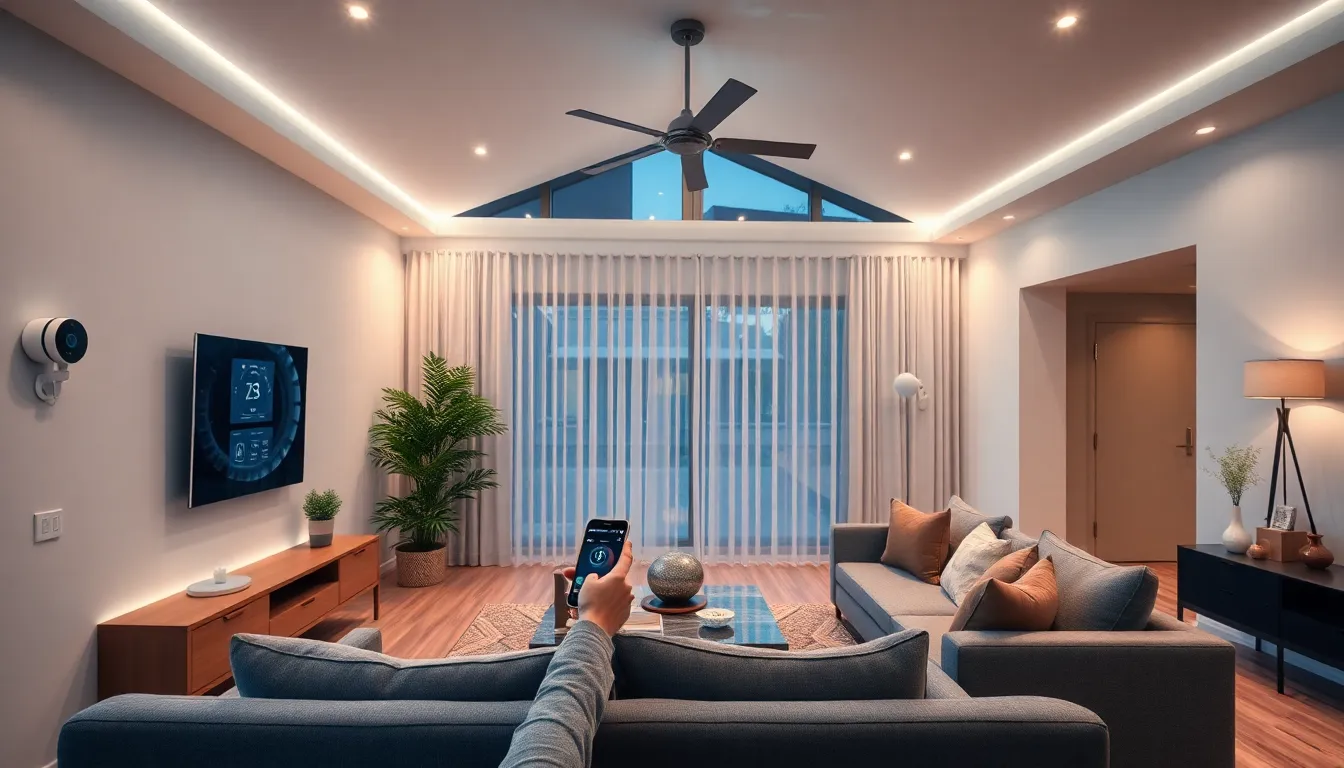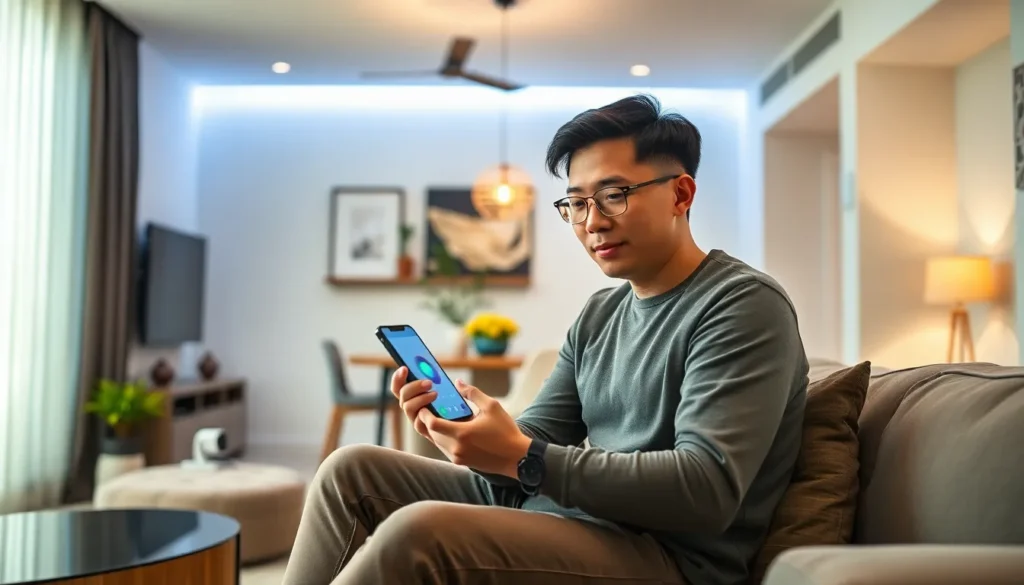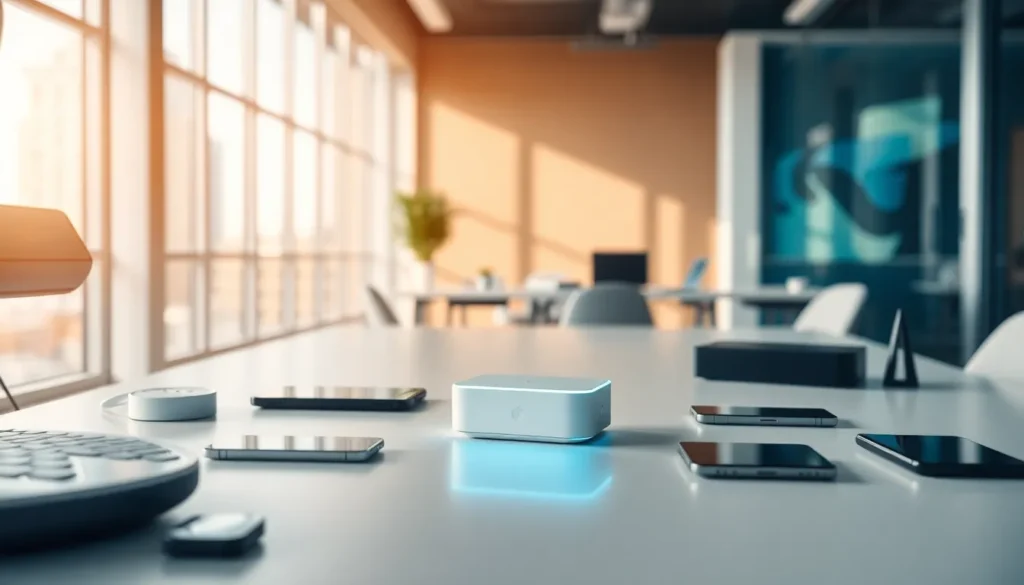Table of Contents
ToggleImagine walking into your home after a long day, and with just a simple command, the lights dim, your favorite playlist starts, and the thermostat adjusts to the perfect temperature. Sounds like magic, right? Well, welcome to the world of home automation systems, where technology meets convenience in a way that even your grandma would approve of—if she can figure out how to use the remote.
Overview of Home Automation Systems
Home automation systems integrate various technologies to manage household functions efficiently. These systems allow users to control devices like lights, thermostats, and security cameras through a central interface. Utilizing a smartphone or tablet for remote access enhances convenience and flexibility.
Smart lighting controls enable automatic adjustment based on occupancy and time of day. Programmable thermostats optimize energy usage by learning user preferences and adjusting temperatures accordingly. Home security systems integrate alarms and cameras for enhanced safety.
Voice-activated assistants provide an intuitive way to operate devices hands-free. Examples of these assistants include Amazon Alexa, Google Assistant, and Apple’s Siri. They respond to simple commands, making daily tasks more efficient.
The simplicity of setup adds to the appeal of home automation. Many systems offer plug-and-play devices that connect easily to existing home networks. Additional capabilities arise through smart hubs, which unify device management in a single application.
Costs for these systems vary significantly, depending on complexity and device selection. Basic setups may start around $100, while comprehensive systems can reach several thousand dollars. Evaluating specific requirements ensures the right technology fits individual needs.
Interconnectivity plays a vital role in the effectiveness of home automation. Devices from different manufacturers can work together through established standards like Zigbee and Z-Wave. This compatibility enhances user experience, allowing seamless integration and control across multiple systems.
Overall, home automation systems represent a significant advancement in smart living. They not only provide enhanced convenience but also contribute to energy efficiency and improved home security. Innovations continue to emerge, making these systems increasingly accessible and versatile.
Types of Home Automation Systems

Home automation systems encompass various technologies that enhance convenience and efficiency. Understanding different types allows users to choose the best fit for their needs.
Smart Lighting
Smart lighting systems provide automated control over home illumination. Users can adjust brightness, color, and scheduling through smartphone apps or voice commands. Integrated with motion sensors, lights can turn on when someone enters a room and turn off when the space is unoccupied. Energy savings come from programmable features that optimize lighting conditions based on time and presence. Additionally, new technologies allow for remote control, enabling adjustments while away from home.
Smart Security
Smart security systems offer comprehensive solutions for home safety. These systems typically include surveillance cameras, motion detectors, and smart locks. Users receive real-time alerts on their smartphones, allowing immediate response to potential intrusions. Cameras equipped with night vision provide surveillance even in low-light conditions. Many systems integrate with existing home networks for seamless functionality. Remote monitoring enables users to keep watch over their property while away, enhancing peace of mind.
Smart Thermostats
Smart thermostats contribute to energy efficiency and comfort. They learn user preferences and adjust heating and cooling accordingly. Users can program schedules or make adjustments remotely through apps. Advanced models feature geofencing technology, adjusting temperatures based on users’ locations. Energy usage reports let households track consumption patterns. Significant savings come from optimizing heating and cooling based on real-time data and forecasts.
Benefits of Home Automation Systems
Home automation systems provide numerous advantages, enhancing daily living and increasing convenience, energy efficiency, and security.
Convenience and Comfort
Home automation systems simplify everyday tasks. Users can control lights, music, and temperature with a simple voice command or mobile app, streamlining routines. Systems often include scheduling features, allowing devices to operate automatically at set times. Smart assistants enable hands-free control, providing effortless interactions with technology. Automated blinds adjust open and close times, aligning with natural light patterns. Overall, these systems create a customized living environment that adapts to individual preferences.
Energy Efficiency
Energy efficiency represents a significant benefit of home automation systems. Smart thermostats optimize heating and cooling by learning user habits, ultimately reducing energy waste. Motion sensors ensure lights operate only when rooms are occupied, saving electricity. Many systems send alerts about energy usage, helping users track and manage consumption effectively. Integrating devices such as energy-efficient bulbs further enhances savings. With remote access, users can adjust settings on the go, ensuring homes remain energy-efficient even during extended absences.
Enhanced Security
Enhanced security is a crucial aspect of home automation systems. Smart security cameras provide real-time monitoring, allowing users to check their property from anywhere. Automated locks enable remote locking and unlocking, ensuring peace of mind when away from home. Intruder alerts notify users instantly in case of suspicious activity, enhancing overall safety. Integrating alarms with smart lighting increases visibility during emergencies, enhancing response efforts. These interconnected security features create a comprehensive safety net, making homes safer and more secure.
Challenges and Considerations
Home automation systems present various challenges and considerations that users must address. Understanding these factors ensures a smooth and effective integration of technology in daily life.
Initial Costs
Initial costs prove significant when evaluating home automation systems. Basic setups range from $100, while comprehensive installations can soar into the thousands. Users must account for device purchases, installation fees, and potential maintenance expenses. Customization also influences the total investment, as tailored solutions often involve additional costs. Budgeting appropriately becomes essential to ensure the selected system meets both needs and financial constraints.
Privacy Concerns
Privacy concerns rank as a major issue with home automation systems. Many devices collect data, such as usage patterns and personal preferences, raising questions about data security. Owners should consider how manufacturers handle, store, and protect this information. Ensuring that devices have robust security features, such as encryption and secure access protocols, becomes vital. Maintaining awareness of potential threats helps users safeguard their private information while enjoying the benefits of automation.
Future Trends in Home Automation Systems
Emerging innovations continue to shape home automation systems. Users increasingly seek advanced features such as AI-driven automation, providing personalized experiences through predictive analytics. Smart devices will likely adopt machine learning algorithms, improving their ability to adapt to individual habits and routines.
Integration with home energy management systems is gaining traction. This integration allows users to monitor and optimize energy consumption in real-time, promoting sustainability. Solar panel integration further enhances efficiency, enabling users to manage energy usage more effectively.
Voice control technology is evolving rapidly. Future systems will utilize natural language processing, making interactions smoother and more intuitive. Increased reliance on conversational interfaces will enhance user engagement, empowering individuals to control devices effortlessly.
Interoperability remains a key focus. Manufacturers are prioritizing compatibility among devices, ensuring seamless communication regardless of brand. This shift enhances user experience by creating a unified system where devices work in harmony.
Furthermore, security innovations are becoming paramount. Enhanced encryption methods and biometric authentication will bolster user data protection, addressing privacy concerns. With the rising number of connected devices, robust security measures are vital to safeguarding personal information.
Customization features are also on the rise. Users will experience optimized interfaces tailored to their preferences, making interactions more accessible. This trend reflects the growing demand for individualized smart home solutions.
Lastly, adaptability is critical. Systems equipped with modular designs will allow users to scale functionality based on their needs. As technology evolves, flexible home automation systems will support an array of devices and functions, accommodating changing lifestyles effortlessly.
Home automation systems are revolutionizing how people interact with their living spaces. By offering seamless control over various household functions they enhance convenience and security while promoting energy efficiency. The integration of advanced technologies allows for easy management of devices through intuitive interfaces and voice commands.
As the landscape of smart living continues to evolve users can expect more personalized experiences and improved interoperability among devices. While initial costs and privacy concerns remain important considerations the benefits of adopting these systems far outweigh the challenges. Embracing home automation not only simplifies daily tasks but also paves the way for a more sustainable and secure future.




